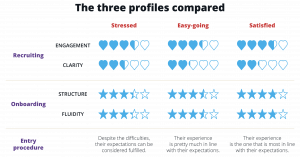Zeneration Time
Jobs, ambitions, and attitudes from A to Gen Z.
The project
As change partners and experience designers, we are naturally inclined to be people-centric in the transformation journeys we activate for our clients.
At the end of 2019, as a new emerging group of consumers and workers entered the market, we noticed how the behaviors of younger users were changing, or rather, bringing new influences dictated by the birth of a new generation: the Zeta. This is the generation that includes people born between 1996 and 2010, straddling the end of the old and the beginning of the new millennium.
Taking the first steps toward the discovery of their needs and choices was not easy.
Indeed, it’s only been a few years since Zetas drew attention to their purchasing and relationship dynamics with organizations and stopped being considered teenagers, permanently stealing the spotlight from Millennials.
We felt it was essential to anticipate their knowledge and to be ready for our employee and customer experience projects, aware of how historical events and the current context have influenced their behaviors and their interaction logics, in order to foresee the impacts and offer the right answers to companies interested in welcoming and attracting them.

We discuss this in a conclusive report, released as a supplement to the November 2021 issue of HBR Italia, which brings together both the identity system (close to values and historical background) and the behavioral system (reflecting the mechanisms of relationships between people & people, and people & organizations) of the new population of users.
The importance of the topic
The starting point that led us to write “Zeneration Time – Work, ambitions and attitudes from A to Gen Z”, actually takes its cue from a generic interest in the international context, with a broader spectrum that allowed us to identify the distinctive traits of the “new young people”, leading us to understand the themes and guidelines that guided us in the deepening of a study focused both on the international comparison and on the national fabric of our interest.
Once we had explored the historical context, identity, social relations and the relationship with technology – typical traits shared by all the Zetas around the world – we approached the Italian context, focusing on the theme of employee experience. We did so by bringing on board some corporate organizations that allowed us to get in touch, through a qualitative research, with 256 newly employed participants.
With the support of Bip, E.ON, and Sia (and their Zetas as they enter the workforce for the first time), we gathered useful information on key aspects of the employee experience as they transition between the academic and professional worlds:
- Continuity with their studies
- Appreciation of the work environment
- Recruitment process preferences
- Types of outside work hours training
- Relationships and intergenerational coexistence
Therefore, not only a broad view of the international context, but also a practical and close detail of the sensitivities and perceptions of the Italian generation entering the workforce for the first time.
What have we discovered? All the information gathered from this more qualitative approach – that provided us with interesting highlights from the perspective of the first step into the workforce – can be found within “Zeneration Time – Work, ambitions and attitudes from A to Gen Z” in the form of profiles, identified as the Stressed, the Easygoing and the Satisfied. A new way to read the results of what we identify as the spirit assumed by young people to face the selection process in the company.

Main themes emerged
Nativi digitali e influencer nell’animo, quello che abbiamo notato è che la pandemia ha affermato e potenziato la capacità degli Zeta di sfruttare il digitale come mezzo per rincorrere i propri sogni, realizzare nuove ambizioni e aumentare lo scambio e la contaminazione con realtà lontane.
Sono gli stessi Zeta a conoscerne le opportunità e ad attivare nuovi comportamenti, e sono gli stessi neo-lavoratori che aspettano di essere considerati nei meccanismi progettuali delle aziende per farne parte e far conoscere il loro potenziale innovatore.
Nel nostro inserto che accompagna l’uscita del numero di novembre di HBR Italia, oltre allo spaccato italiano, vengono affrontate tutte le conseguenze che il rapporto simbiotico con la tecnologia sta generando nel sistema identitario della Generazione Z: l’attenzione per la privacy, l’attivismo sui temi sociali, la gestione del tempo, la formazione non convenzionale, l’imprenditorialità e le relazioni sociali a distanza. Sono solo alcuni degli effetti dell’influenza del digitale con cui sono stati abituati ad interagire fin da piccoli.
Digital natives and influencers at heart, what we’ve noticed is that the pandemic has affirmed and enhanced the Zetas’ ability to exploit digital as a means to chase their dreams, realize new ambitions and increase exchange and contamination with distant realities.
It is the Zetas themselves who are aware of the opportunities it gives, and activate new behaviors, and they are the same new workers who are waiting to be considered in the design mechanisms of the companies in order to be part of them and show their innovative potential.
In our supplement that comes with the November issue of HBR Italy, in addition to the Italian picture, we address all the consequences that the symbiotic relationship with technology is generating in the identity system of Generation Z: attention to privacy, activism on social issues, time management, unconventional education, entrepreneurship and long-distance social relationships. These are just some of the effects of the influence of the digital with which they have been accustomed to interact from a young age.
Thus, let’s not forget that, in addition to being professionals, young Zetas themselves are citizens, users and customers, individuals who bring their sensibilities from the outside world to the company’s osmotic ecosystem. This is why brands need to start considering them in the areas of customer and employee experience, increasing awareness of their background and activating new strategic directions to continue to innovate, embracing intergenerational differences.
The first step is to radically change the way experiences are designed, taking into account their need to deal with simplified interactions, memorable experiences, all at just a click away. Like the ones they experience every day with their peers outside of work environments.

 4 November 2021
4 November 2021
